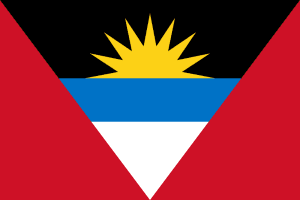
| Colors | HEX Code | RGB | CMYK |
|---|---|---|---|
| Black | #000000 | 0, 0, 0 | 0, 0, 0, 100 |
| Blue | #0469B3 | 4, 105, 179 | 98, 41, 0, 30 |
| White | #FFFFFF | 255, 255, 255 | 0, 0, 0, 0 |
| Red | #CE1126 | 206, 17, 38 | 0, 92, 82, 19 |
| Yellow | #FCD116 | 252, 209, 22 | 0, 17, 91, 1 |
The Flag of Antigua and Barbuda is made of an upside-down triangle that includes three horizontal stripes, colored black, white, and blue. There is a yellow rising sun with seven edges on the black stripe. The stripes are cut by a V shape, and two opposing red triangles are left on the middle and lower sides of the flag.
Antigua and Barbuda Flag Meaning
The different colors and shapes stand for different features of the Islands. The black stripe represents the African roots of the people on the islands, and the red represents the blood of the slave forefathers and the dynamism of people. The V represents victory, and the rising sun represents a new era. The blue, white, and Gold represent the beautiful nature that attracts tourists to the islands. These are the sea, sun, and sand.
Antigua and Barbuda Flag History
Antigua and Barbuda were discovered by Christopher Columbus and named by him. In 1632, Britain colonized the islands. Soon they became a center for sugar plantations and slave trade. In 1967, Antigua and Barbuda could achieve a form of self-government, while still having strong relations with the United Kingdom. To celebrate the new independence, a contest was held to choose the best flag design. The winner was Sir Reginald Samuel, an art teacher whose design was chosen among 600 designs presented in the contest. On November 1, 1981, Antigua and Barbuda became a completely independent country. The flag remained the same as it was before complete independence, and no changes were made to it.